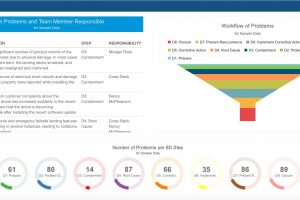Fault Tree Analysis (FTA) is a top-down deductive approach used to analyze risk and safety issues. Starting with a highly catastrophic or undesirable event, boolean logic is employed to model the effects of low level events which ultimately may lead to the top level failure.
Fault Tree Diagrams
Fault Tree diagrams are constructed by starting with a top level undesirable event. Typically, the analyst wants to assess the probability, or likelihood, of this catastrophic, or unwanted, event and then take steps to eliminate, mitigate, or minimize its occurrence. In some instances, analysts may have a contractual requirement to make an assessment to ensure a critical event falls below a specific likelihood of occurring. Fault Tree employ diagrams using Boolean logic gates (AND, OR, etc.) in combination with defined failure events to analyze risk metrics.
Safety and Risk Assessment Spans Industries
Risk and safety assessment activities are vital across many industries, and especially those in known high-risk areas such as nuclear power, medical, and aerospace. However, fault trees are also used in a wide range of industries to aid in quality improvement and risk reduction. Fault tree analysis is employed across the spectrum because it is a valuable tool to quantify the risk associated with events that can lead to system failures of any kind.
Why do Fault Tree analysis?
Whenever there is a need for high-level risk assessment, or for the evaluation of events leading to mission critical or catastrophic failures, fault tree analysis is the tool of choice. Even if you have only one main catastrophic event you want to analyze for its likelihood of occurrence, a fault tree analysis is greatly advantageous. Any time you have known failure events and want to assess the probability of combinations of those events leading to system failure of any kind, a fault tree analysis provides valuable metrics unavailable with other qualitative tools.
How do I do a Fault Tree analysis?
Almost all fault tree analyses are done using a specific software tool designed for the process. There are other means of performing a fault tree analysis, but those are extremely limited in comparison to using a software tool. Look for a tool that provides an easy-to-use diagram interface combined with a powerful computational engine. A web-based package allows you access to your fault tree analysis across remote teams or distributed locations.
Relyence Fault Tree
Relyence Fault Tree is a powerful tool providing everything you need for performing comprehensive fault tree analyses. Offered on the web and supporting a mobile-friendly interface, Relyence Fault Tree is built with today’s technologies in mind. Relyence Fault Tree makes fault tree construction not only easy, but also eye-catching, and then adds on an impressive calculation engine supporting a variety of risk and safety metrics.
Contact us today so we can talk about your fault tree needs and how Relyence Fault Tree can help, or sign up today for our free trial to see Relyence Fault Tree in action.




